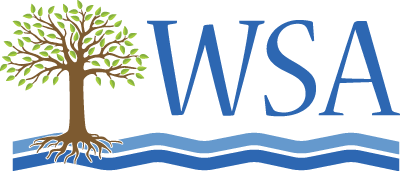Leaves
This page is for Master Watershed Stewards considering a Behavior Change campaign in their communities. To learn more about what you can do as an individual click here.
A major pollution source for much of the Chesapeake Bay is nutrient pollution. One major source of excess nitrogen may not be obvious to most people. Leaves, grass and other yard debris contain nitrogen that is released when they break down in the water. When the organic matter decomposes, the nitrogen released becomes a source for algae growth. When the algae dies and is decomposed by bacteria, the bacteria use up much of the oxygen dissolved in the water. Leaves decaying in the water use up to 7 times more oxygen than those decaying on land. This robs oxygen from fish, crabs and other aquatic organisms. Water that washes down storm drains and gutters goes directly into streams and creeks without being treated. Leaves, yard debris and any other pollutants that go through your storm drains will end up in local waterways. Clogged storm drains and gutters can also cause water to pass by drains and flood roads and neighboring properties. Choose these behaviors if your community has a lot of impervious surface and a large amount of deciduous tree canopy.
CAMPAIGN DEVELOPED BY WSA:
Commitment (CT) Pledge
Social Norms (SN) Community Events
Social Diffusion (SD) Community Events
Prompts (P) Magnet , Social Media
Communications (C) Doorhanger, Email V1, Email V2, Email V3, Email V4
Incentives (I) Leaf Bags, Leaf Bag Coupons
Convenience (CV) Lawn Care Services, Leaf Bags
* Available in editable and/or hardcopy formats from WSA. Click for digital version or email setgen@aawsa.org to check hardcopy availability.
Click here for a brief overview of the Leaves Campaign that WSA already has developed.
Behavior: Remove all yard waste from hard surfaces on and around your property and mulch it, bag it, or compost it.
Some of the common perceived or actual barriers to properly removing and disposing of yard waste from hard surfaces include:
Some of the common perceived or actual benefits for people to properly remove and dispose of yard waste from hard surfaces include:
1. Sense of pride
2. Curb appeal
3. Removal of safety hazards- slippery conditions and potential flooding
4. Sense of personal responsibility
5. Community leadership, lead by example
6. Environmental benefit
Some of the common perceived or actual benefits for keeping leaves and yard waste out of storm drains and gutters include:
1. Looks nicer
2. Good for the environment
3. Prevents flooding



